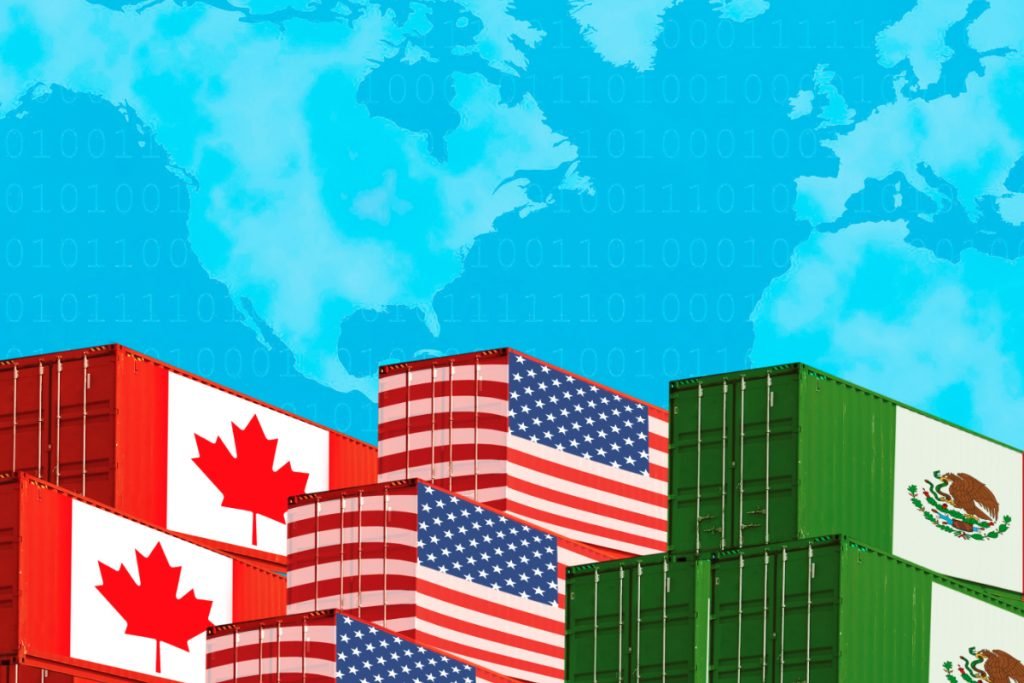The new trade agreement between the three North American countries took effect from July 1st, 2020 after three years of negotiations.
Although it introduces changes in some key aspects, the USMCA seeks to preserve the commercial exchange between the three countries, which represents about US $1.2 trillion a year.

A brief history
The North American Free Trade Agreement (NAFTA) was an agreement signed in 1994 by Canada, United States and Mexico to kickstart a trilateral trade bloc in North America.
NAFTA is believed by many to have replaced the 1988 Canada-United States Free Trade Agreement.
When NAFTA took effect in January 1994, setting trade terms between the United States, Mexico, and Canada, it was lauded as “the most advanced trade deal in the world.”
It wasn’t so long after then that technological advancements such as the internet, eCommerce, and Digital Trade boomed, raising concepts above the scope of the agreement.
This brought about a need for a new agreement which only began when President Donald Trump threatened to pull out in 2017.
A new dawn
Negotiations for the new agreement began in 2017 after President Donald Trump threatened to withdraw from Nafta as it’s unprofitable to his country, a reflection of the commercial approach of his Administration.
The new agreement was approved by the legislatures of Mexico in 2019, and that of the United States and Canada followed closely in 2020 before the parliament was shut down due to the coronavirus pandemic.
The new agreement is officially known as the United States-Mexico-Canada Agreement (USMCA) or, in Canada, as the Canada-United States-Mexico Agreement (CUSMA).
The agreement took effect on July 1, 2020, with extensive new provisions and increased trade opportunities for U.S. businesses.
The agreement establishes a 16-year sunset clause and is also subject to a review every six years.
Made in North America
The agreement covers key areas of all economies involved and we would be addressing the major ones as you read on.
Automobile
One of the most relevant points of the USMCA refers to the automotive sector: the new agreement raises the percentage of North American content of cars and trucks built in the region from 62.5% (stipulated by Nafta) to 75%.
It also promotes the use of North American steel and aluminium. In addition, for a vehicle to be exempted from fees, between 40% and 45% must have been manufactured in ‘high wage’ areas ($16 an hour or more) to prevent US industries from breaking it and Canada outsourcing their production to Mexico.
Milk, chickens and eggs
Another key aspect is agricultural products. Canada enabled a 3.5% share of its dairy market (about US $16,000 million) for US milk producers.
The US will also be able to increase exports of some products such as skim milk and protein-fortified milk in return, it promises to lower Canadian milk tariffs.
Starting in the 6th year of the USMCA, tariffs are released so that the US can export up to 57,000 tons of chicken and 10 million dozen eggs and it’s equivalents to Canada.
Cheaper drugs
The USMCA is also projected to help reduce the price of some pharmaceutical products.
The new agreement limits patent protection for some remedies, for example, the 10-year exclusivity of biotech drugs and it also eliminates the need for patents for new uses for products already on the market.
Intellectual property
In relation to intellectual property and digital products, copyright extends from 50 to 70 years (except in the US, where it was already in force) after the death of the author.
Duties and other tax charges are prohibited on digital products such as music, games, videos and ebooks, among others.
On the other hand, digital platforms are protected from liability for the information published by their users.
Textile
In relation to textiles, some revised rules have incentivized the use of regional inputs, while restructuring Tariffs Preference Levels (TPLs) and a new robust custom enforcement provision.
The revised rules allow for flexibility by increasing the “de minimis” percentage of non-originating inputs from 7 to 10 percent.
Labour guarantees
The USMCA also focuses on labour rights, especially in Mexico. Not only does it give workers greater guarantees and punish products made with slave labour, but it also gives the possibility of convening panels of international labor experts to arbitrate in the event that the right to form unions or bargain collectively is not guaranteed, for example.
Economic sanctions are foreseen for the products of the factories in violation.
The signing of the agreement, during the G20 held in Buenos Aires New arbitration system
The treaty also updates the dispute resolution system, limiting the margin a company has to challenge a government’s decision.
The previous system allowed any North American company that operates abroad to take the case to an international court, the Investor-State Arbitration of Disputes (ISDS).
Now that is limited to some specific industries and specific issues such as expropriations, discrimination against foreign companies.
Environment a pending subject
With regard to the environment, a commitment to contribute to the reduction of climate change is not specified.
It is enough to remember that Trump decided to abandon the Paris Agreement, although Canada and Mexico ratified it. It does demand that the three countries adhere to the Montreal Protocol, to eliminate substances that damage the ozone layer.
There are also international agreements on the protection of wetlands, endangered species, Antarctic marine life, and whaling and tuna fishing.
Conclusion
The USMCA has some major consequences for the Canadian dairy industry as they accepted restrictions on exporting some dairy products. The United States seems to be the biggest winner of them all.
The export limits accepted on some of Canada’s dairy products would be the first and it sets a dangerous precedent, as this is the first time a country has accepted export restrictions to all of the countries globally under a bilateral or trilateral trade agreement.

